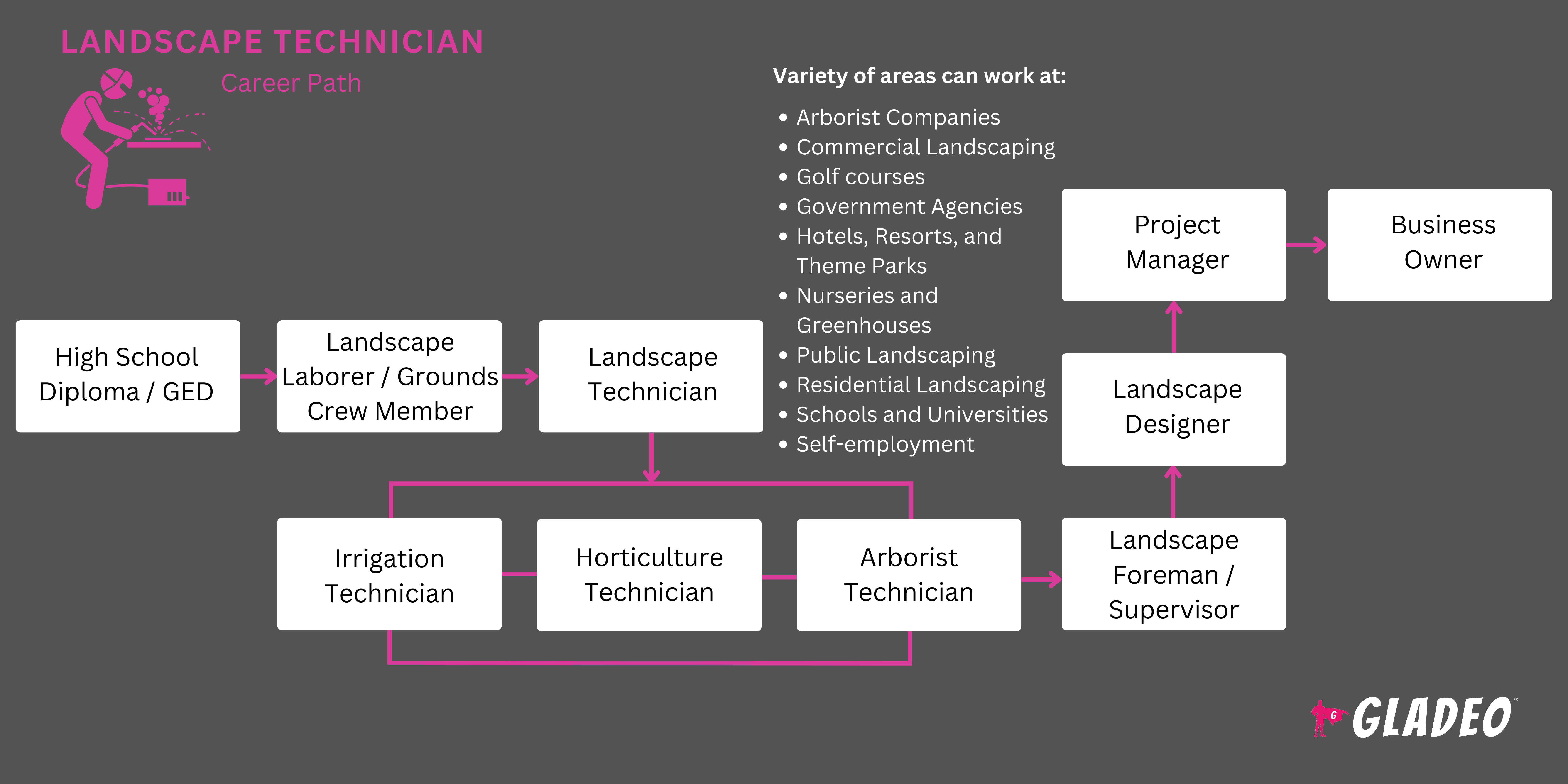聚光灯
园丁,绿化管理员,地面维护工人,地面人员,地面工人,地面/维护专家,地面管理员,景观专家,景观技术员,外部维护工人
Landscape Technicians, also known as Grounds Maintenance workers or Groundskeepers, are in charge of keeping a property’s grounds and landscaped areas looking sharp at all times. They perform a wide variety of outdoor duties such as planting flowers, shrubbery, and small trees, as well as keeping all of those trimmed, mulched, watered, and free from pests. Other parts of the job include mowing and trimming lawns, removing weeds, raking or blowing leaves, picking up fallen tree limbs, clearing sidewalks, and in some cases assisting with the installation of patios, decks, sprinklers, or lighting systems. They might even be tasked for maintaining parking areas, playgrounds, fences, or public park benches.
Landscape Technicians can be found working on virtually any type of property, from private residences to malls, office parks, college campuses, public areas, golf courses, and many other spaces. They usually follow the guidance outlined by their employer’s grounds or facility manager, and designs made by a professional Landscape Architect. Specialized workers, such as those working at cemeteries or sports fields, have additional job-specific duties. Many receive training to spray pesticides on plants and soil.
While they often go unnoticed, Landscape Technicians are out there working hard to keep natural environments beautiful and healthy for everyone’s use and enjoyment!
- 在户外与大自然一起工作
- 保持植物、灌木和树木的健康和安全不受虫害影响
- 日常体育锻炼
- 确保公共区域得到良好的维护,供社区享受。
- 维护独特的私人场所,如公墓、高尔夫球场和田径场,使它们看起来对游客很有吸引力。
Working Schedule
Landscape Technicians usually work full-time, sometimes on a seasonal basis since there is less to do during winter months in many states.
Typical Duties
- 在公共或私人场地外工作
- 按照预先安排的模式种植不同的灌木、植物和花卉类型
- 在灌木、植物和花卉生长的土壤中拔除杂草
- 浇水、施肥、修剪灌木和其他种植的物品
- 视情况喷洒杀虫剂
- 修剪和修剪草坪区域
- 使用喷灌系统保持草坪和花园的浇灌
- 种植小树,如果需要的话,建立支撑物以保持它们的直立性
- 检查树木的健康状况和疾病或腐烂的迹象;根据需要修剪和移除树枝
- 耙和吹叶子
- 在一些工作场所,如商场,照顾某些室内植物
- 铺设人行道、桌子或庭院材料
- 驾驶卡车将设备拉到工作现场;在工作现场周围驾驶小型车辆
- 帮助用石头和雕塑装饰花园或喷泉区
- 根据需要,协助安装洒水车或照明系统
- 轻度绘画工作
额外责任
- 穿着所有的个人防护设备;实行良好的安全程序
- 维护车辆和工具/设备的库存
- 确保为当天的工作准备好所有必要的物品,包括割草机的燃料
- 保持人行道或停车区无杂物
- 在冬季清除人行道上的积雪
- 履行特定工作地点的专门职责,如运动场、高尔夫球场或公墓。
- 特殊的劳动任务可能包括架设临时围栏、草皮维护、用电锯砍树、用反铲挖坟、游泳池维护等等。
软技能
- 能够遵循指示
- 注重细节和标准
- 以客户服务为导向
- 快速反应时间
- 良好的手眼协调能力
- 手和手指的灵活性
- 正常色觉
- 观察者
- 病人
- 以安全为导向
- 力量和耐力
- 强大的倾听能力
- 团队合作
- 时间管理
技术技能
- 了解设计布局的能力
- 使用个人防护设备,如眼睛和听力保护装置、手套、钢头靴或其他规定的物品
- 熟悉适用的国家和地方安全标准
- 安全使用动力设备和手动工具的培训(包括割草机;电动或气体动力除草机;修剪器、绿篱剪;铁锹、铁铲和其他园艺工具)。
- 掌握农药和化肥的使用和安全处理知识
- 熟悉喷水灭火系统和照明系统(如适用)。
- 根据工作需要,使用其他专业设备
园艺工人种植树木、花卉和灌木,以创造新的室外空间或改造现有空间。他们还修剪植物、施肥、覆土和浇水。有些人负责平整和安装草坪,或建造人行道、庭院和露台等硬质景观。还有人帮助安装照明或喷灌系统。园艺工人受雇于各种住宅和商业环境,如住宅、公寓楼、办公楼、购物中心以及酒店和汽车旅馆。
园艺 工人也称场地管理员,负责维护场地。他们照料花草树木,耙落叶并覆盖覆盖物,清除人行道上的积雪。他们的工作场所包括运动场、高尔夫球场、墓地、大学校园和公园,以及许多与园林绿化工人工作场所相同的地方。他们还负责人行道、停车场、喷泉、栅栏、花盆和长凳以及场地管理设备的适当维护。
球场管理工人负责维护运动场的天然和人造草皮,使其保持最佳状态,标出边界,并在活动前在草皮上涂抹队徽和队名。他们定期对草坪进行修剪、浇水、施肥和充气。他们必须确保铺设天然草皮的场地下层土壤的成分符合排水要求,并能支撑场地上使用的草坪。
公园和娱乐设施的场地管理员负责养护草坪、树木和灌木;维护操场;清洁建筑物;保持停车场、野餐区和其他公共场所无垃圾。他们还可能安装和拆除雪栅栏,维护游泳池。这些工人检查建筑物和设备,进行必要的维修,并保持一切粉刷一新。
一些场地管理员专门负责墓地和纪念花园的维护工作。他们通常使用反铲挖掘机将坟墓挖到指定深度。他们定期除草、施肥和使用其他化学品、修剪灌木和树木、种植花卉,并清除坟墓上的杂物。
球场管理员 负责维护高尔夫球场。他们的工作与场地管理员类似,但也会定期重新布置推杆果岭上的球洞,维护球场沿线的长凳和发球台标记,并对草坪进行更严格的维护。
农药处理工、喷洒工和施用工将除草剂、杀菌剂和杀虫剂施用到植物或土壤中,以预防或控制杂草、昆虫和疾病。在化学草坪或树木服务公司工作的人员更为专业,他们检查草坪是否有问题,并施用肥料、杀虫剂和其他化学品,以刺激生长,预防或控制杂草、疾病或虫害。
树木修剪工和修枝工,也称为树木学家,负责剪去树木或灌木上的枯枝或多余的枝条,以清理公用设施线路、道路和人行道。其中许多工人致力于改善树木和植物的外观和健康状况,有些人专门从事树木疾病的诊断和治疗。还有一些人专门从事观赏树木和灌木的修枝、修剪和整形工作。树木修剪工在工作时会使用链锯、削片机和树桩粉碎机。在电线附近修剪时,他们通常使用车载升降机和电动修枝剪。
- 公寓大楼
- 教育机构
- 地方和州政府机构
- 连锁酒店
- 办公大楼和公园
- 私人住宅
- 娱乐场所(游乐园、田径场、高尔夫球场)。
- 自营职业者(或景观设计服务的所有者)。
- 购物商场
园林技术人员工作辛苦,每天大部分时间都在户外度过。他们要面对酷暑严寒、日晒雨淋和风吹雨打。他们的大部分时间可能都是独自工作,在最后期限内完成体力要求很高的任务,以便能够转到下一个任务或工作现场。尽管需要高效工作,但他们仍被要求保持高标准。因此,他们需要耐心和对细节的关注,以及连续数小时相对快速工作的能力。
就牺牲而言,重要的是要了解园林技术员面临着许多工作场所的危险。他们在工作时经常会使用危险的工具,因为疲劳、重复工作而感到无聊,而且可能会在恶劣的天气下工作,这可能会弄湿手或工具。除非工人穿戴适当的防护装备,时刻注意安全,并接受正确使用工具和设备的培训,否则这些因素的综合作用可能会导致受伤。听力保护是一个经常被忽视的因素,因为工人可能会操作或靠近声音较大的设备。
另一个潜在的牺牲因素是,在冬季,工作可能是零星的,这时要做的事情较少,或职责可能会发生重大变化(例如,可能需要除雪,或摆放节日装饰品,而不是修剪草坪或浇灌植物)。
由于房主和机构希望通过投资园林绿化来美化旧物业,因此预计就业增长将非常好。研究表明,年轻房主也在寻求更多的景观美化服务,以此来保护环境。事实上,"室外空间 "和 "室外房间"(如有顶露台或庭院)已成为一种趋势,这可能需要园林技术员的技能。
在商业领域,当前的重点是绿色倡议和工作场所健康,这应该会让景观设计师忙得不可开交,因为公司会提供更多的户外区域,以促进工人的健康和工作满意度。与此同时,不可预测的国家天气模式可能会导致工作要求发生意想不到的变化,因为暴风雪、干旱或火灾可能会破坏履行典型职责的能力。然而,园艺工人在此类事件发生后的清理工作中发挥着至关重要的作用。
许多园林工人喜欢在气候条件不太恶劣的温带地区工作,那里一年四季都有稳定的工作。值得注意的是,虽然该行业在不断发展,但却没有足够的工人来填补空缺。根据全美园林专业人员协会的数据,82%的公司领导担心 "熟练劳动力短缺 "是 "限制该行业发展的主要因素"。
园林技术员不介意弄脏自己的双手!他们可能一直喜欢户外活动,不怕体力劳动。他们热爱大自然,具有长期在户外工作的耐力和耐心,这可能是他们多年来培养的能力。
他们既要花时间正确完成工作,又要讲究效率,因为要做的事情很多,而完成的时间有限!这种时间管理技能也可能是从小就学会的。地勤人员在工作现场保持良好的安全意识,这可能是他们在年轻时接受培训、在家庭物业工作或在高中工作时获得的。
他们可能并不内向,但却能自如地花几个小时独自工作,作为一个更大团队的一部分,他们分散在正在工作的场地周围。他们有扎实的职业道德,以目标为导向,因此能按部就班地完成任务,保持工作进度!
- 园林技术员通常持有学校文凭或普通教育文凭。大多数初级职位没有正式的学历要求
- 某些工作可能需要在设计、园艺、树艺或设备使用方面的具体培训。
- 工人接受在职培训,以确保他们能够处理特定的职责;当他们准备好进步时,他们会接受更多的培训。
- 处理杀虫剂和化肥的工人可能需要通过考试以获得州政府的许可。
- 认证可以提高资历,从而获得更好的机会和晋升潜力。几个选择是。
- 国际树艺协会--注册树艺师、注册树木工人攀爬专家等
- 全国园林专业人员协会- 草坪护理经理、草坪护理技师、园艺技师、室外技师
- 专业场地管理协会- 注册场地经理或注册场地技术员
- 树木护理行业协会-树木 护理安全认证专业人员
- 景观技术员通常不需要上大学就可以开始工作,但有些人在社区学院或职业培训计划中学习课程
- 几乎所有的相关培训都是通过认证项目和在职培训相结合来完成的。
- 根据O*Net Online,18%的景观技术员拥有学士学位,可能是景观设计或相关专业。
- 对于那些旨在完成学士学位的人来说,请与你学校的就业中心讨论,以找到你打算工作的州的最佳薪酬工作机会。
- 看看教授们的传记,看看他们做了什么,并了解你在职业生涯中可能想做的事情。
- 参加可以帮助你获得工具的实践经验的课程
- 了解植物和花卉的类型,以及如何种植和照顾它们
- 阅读有关安全、保护设备和急救的文章
- 通过在Craigslist上找到的兼职工作或通过在Craigslist上发布你想在当地提供的服务的广告来获得工作经验。
- 研究景观设计,关注你所在地区的景观设计,看看哪些类型的植物、花卉、树木和灌木被普遍使用
- 敲定一两个认证项目,完成适用设备操作的培训。记下你所学到的工具和设备的使用情况
- 如果你所在的州有要求,请获得农药和化肥的工作许可。
- 与工作中的景观技术员见面,提出问题和建议
- 观看视频,展示你一天的工作内容。

- 让你的朋友、家人和学校知道你在寻找一份景观设计工作
- 审查Indeed、ZipRecruiter、SimplyHired和Craigslist上的招聘广告。
- 联系当地的景观设计公司,询问空缺职位的情况
- 确保你有足够的工作和学术背景来申请;只申请你能胜任的工作。
- 请一位擅长写作的朋友审阅你的申请,看看是否有错误或可以改进的地方。
- 列出所有相关的工作经验、教育和培训,以及你拥有的证书或执照
- 在面试中要表现得专业,穿着得体,并诚实地介绍自己的背景,给人留下深刻印象。
- 使用正确的术语,并解释你有资格使用的所有工具和设备,以及你所处理的树木、植物和花卉的类型
- 准时上班并表现出积极的态度。表现出主动性和准备性!
- 具有团队精神,注意听从指示,并表现出领导特点
- 掌握所教的每项技能和所展示的每件工具或设备的使用方法。
- 保持对细节的敏锐洞察力,确保你的工作完成得最好。
- 不断学习更多关于你的工作的信息,包括关于植物、花卉、树木和它们生长的各种条件的信息。
- 在尽可能多的设备类型上获得经验
- 志愿处理新的任务,并让你的主管知道你希望增加责任,如管理他人。
- 向你的老板征求关于大学课程、高级培训或认证的建议
- 酌情完成认证和执照的办理
- 妥善保管工具、设备和车辆;根据需要及时进行维护,以确保正常运作
- 如果需要的话,学习技术手册,这样你就知道设备是如何工作的,以及当设备不能正常工作时该如何处理。
- 做一个安全大师,始终穿戴合适的防护设备,同时为其他人树立起遵循的标准。始终遵守安全标准,避免误伤
- 培训新员工,让他们负起责任。以你希望得到的方式对待新员工
世界需要更多合格的景观技术员,但不是每个人都能胜任这项工作。这涉及到大量的劳动,存在危险,工作可能是季节性的,有时人们只是想做一些不同的事情!此外,由于开始工作的学术要求相对较少,除非你有一些专门的技能,否则工资可能有待提高。BLS提供了一些可以考虑的替代职业,如:。
- 农业工人
- 森林和保护工作者
- 景观设计师
- 虫害防治工作者
O*Net Online也提供了一些想法,如农场工人和劳动者或伐木设备操作员。
新闻联播

特色工作

在线课程和工具







